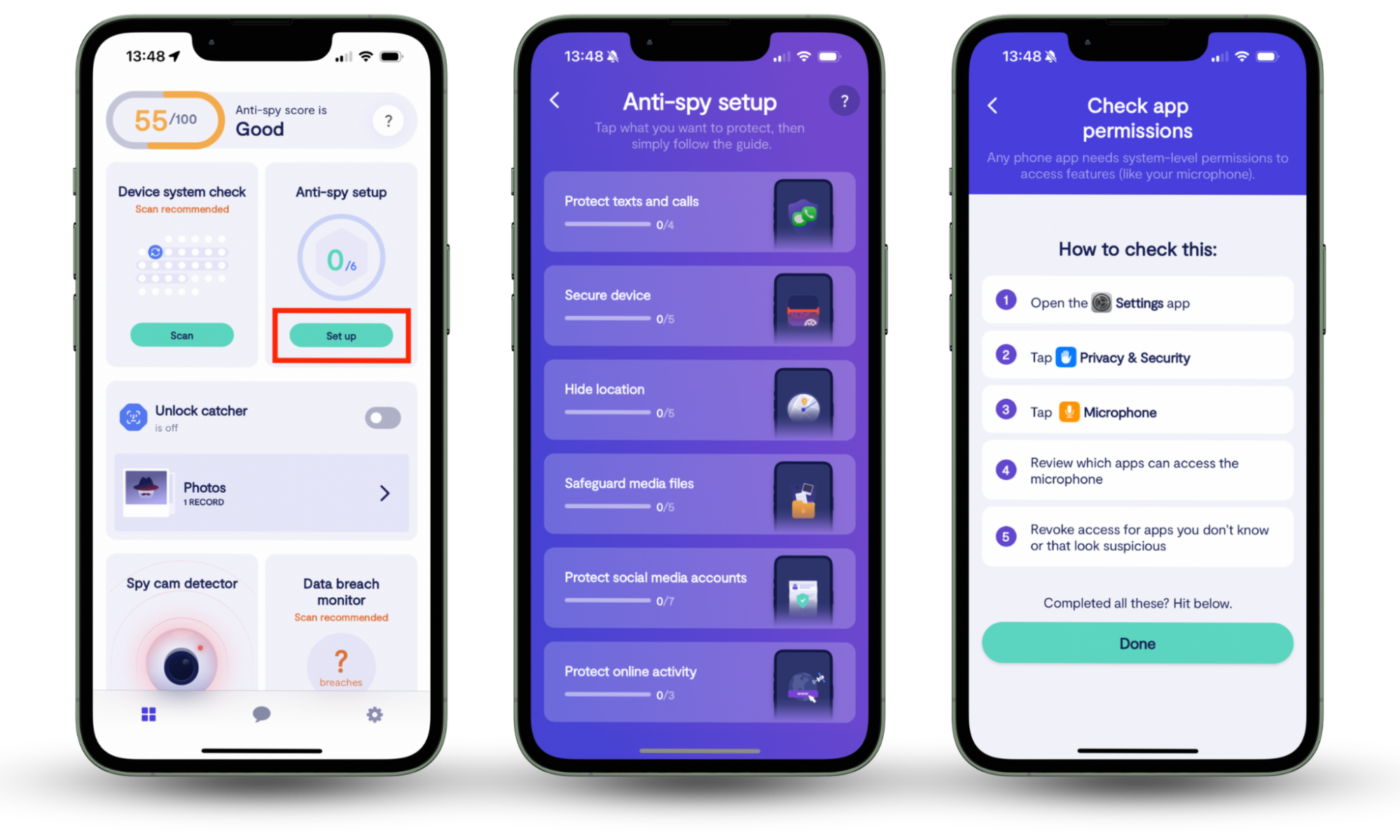Table of contents
- Is Windows Defender good?
- Windows Defender features
- More parental control
- Get access to research-backed protection
- Compatible with other antivirus products
- Defender detects malware files
- Offers protection from internet hackers
- Comes with the security suite
- The downside of Windows Defender
- Users have to use other Microsoft products for full protection
- Doesn't hold up well when accessing phishing sites
- DNS filtering only when using Microsoft Edge
- Doesn't have a password manager
- Pay extra for cloud backup
- Users don't get a VPN
- So, is Windows Defender good enough?
Is Windows Defender good?
Windows Defender, now called Windows Security, which contains Microsoft Defender Antivirus, is Microsoft’s built-in anti-spyware and antivirus protection. It was released by Microsoft in 2006. The tool forms part of Microsoft Security Essentials and is available to Microsoft users for free.
When it was first launched, Microsoft Defender left much to be desired. However, Microsoft has improved the tool over the years and has gained more respect in the industry for the strides it has made in improving its solution. Windows Defender does a decent job of protecting your computer against viruses and intruders. But just how well does it protect your data? Keep reading, we’re exploring that in greater detail below.
Because Windows Defender is pre-installed, Microsoft users don’t have to do anything like set up an account or subscribe to start using Defender. All you need to do is fire up your computer and start enjoying the benefits it offers.
So, what value does Windows Defender add to users?
Let’s have a look at some benefits of using Windows Defender below:
- Windows Defender is more convenient than using a third-party app, as there’s no setup required
- There is no pressure to make a financial commitment on your end, as the tool is completely free for Microsoft users. Most anti-spying tools either come at a cost or hide their key features behind a paywall. This makes them inaccessible for some people — especially in this economy.
- It blocks phishing websites and malicious downloads. This can save you from falling victim to identity theft, fraud, and more.
- You get real-time protection against viruses. Windows Defender quietly works in the background to scan your device for threats and blocks them, all while you use your computer without interruptions.
- In addition to protecting your computer against viruses in the background, Windows Defender allows you to scan your files for malware anytime you want. This prevents new viruses and malware from entering your computer and compromising your data.
- One of the most important benefits is that Windows Defender is easy to use. This makes it suitable for personal, at-home use. Anyone can easily navigate Windows Defender and put it to good use since it’s not an advanced program.
Windows Defender features
Windows Defender has some key features that an anti-spying tool needs. These are the features that make a case for using Windows Defender, especially given that it’s a free app.
Key features of Windows Defender:
- More parental control
- Get access to research-backed protection
- Compatible with other antivirus products
- Defender detects malware files
- Offers protection from internet hackers
- Comes with the security suite
More parental control
Windows Defender’s parental control feature forms part of Windows’ Family options solution in Windows 10 and later versions. Parental control contains various tools to help parents and guardians manage their children’s digital activities. The aim is to keep children safe online and to ensure they’re healthily using the internet.
Here’s what you can do with Windows Defender’s parental control feature:
- Choose the websites your kids can visit in Microsoft Edge. You can achieve this by either blocking specific, inappropriate websites or setting the device to only see websites on the allowed list. The internet is a whole different world. When zoned in, it’s easy to mindlessly or curiously jump from website to website. The more time kids spend online, the more websites they can explore. It’s easy for them to end up on websites they have no business visiting, like adult websites. And it’s just as easy to enter malicious websites, too. Choosing what websites they can visit can limit the probability of this happening.
- Receive weekly reports about what your kids are getting up to online, so you can monitor their online activities. This allows you to make the necessary adjustments or add the relevant controls as needed. If your child spends too much time on a particular website, you can investigate why that is the case.
- Set screen time limits for your kids to ensure they aren’t spending too much time online or using their devices when they shouldn’t. Screen time controls can be set per day or in a single schedule. Any parent knows that social media, games, and other apps are time-consuming and can distract your kids from their school work. When kids spend more time on the internet, it affects other areas of their lives, like their social lives and their sleeping patterns. This isn’t healthy, so setting screen time limits helps you manage your kids’ internet use to ensure it doesn’t negatively impact their health and well-being.
- Set time limits for specific media, apps, and games. Specifying the amount of time kids can spend on specific apps and games helps them have a healthy relationship with those apps and games. It reduces the probability of them getting addicted and allows them to explore other things, like educational websites. It’s also a great way to help your kids lead a balanced life where their digital lives don’t take over their real lives. Kids can request access, which adults can approve in the family safety center.
- Add, remove, and manage family members. Microsoft gives you the power to manage your family members in family options. When your kids grow up, you can remove them and give them their independence. And when your younger kids start using your devices, you can add them to monitor their activity.
- Manage your children’s spending in the Microsoft Store. Parental controls allow you to choose which kids can buy from the Microsoft Store, give them money to spend in the store, and monitor what they’re using it for.
- Find and lock a lost mobile Windows device. Parental controls help you secure and find devices that are either lost or stolen, to ensure your personal data isn’t compromised. This feature is similar to Apple’s Find My feature, which helps to locate and lock down Apple devices that aren’t in your care.
- Adults can view what devices they and other family members are signed in to. Getting an overview of the devices used is another way to manage your kids’ use of technology.
- Adults can also view the health and security statuses of the devices that family members are signed into. This allows you to take action as needed.
Get access to research-backed protection
Defender for Endpoint includes Microsoft Defender Antivirus. The antivirus employs the latest research in the following disciplines to help protect your devices against viruses:
- Threat resistance research
- Microsoft cloud infrastructure
- Big data analysis
- Machine learning.
The antivirus provides protection to your device and in the Microsoft cloud. This ensures that all your files are guarded against threats that could compromise your personal information.
Compatible with other antivirus products
One of the best things about using Windows Defender is that you don’t have to choose between the program and alternative antivirus software. Windows Defender pairs well with other antivirus products, which allows you to strengthen your antivirus protection.
What’s more, Windows Defender’s antivirus protection can run in the background (in passive mode) while a third-party antivirus program is running on your device. This depends on two factors:
- Whether the operating system running on your device allows both a built-in and third-party antivirus to run concurrently. Operating systems that allow this include:
- Windows 10 or later
- Windows Server 2022
- Windows Server 2019
- Windows Server version 1803 or later.
- Whether your computer is running Microsoft Defender for Endpoint.
Take note
Installing a third-party antivirus app on your Windows device will render Windows Defender inactive. If you want to activate it again, you’ll have to turn it on, which will work passively. You have the option to set it to scan your personal computer occasionally.
Let’s break down what Windows Defender’s different modes mean:
- Active mode. In active mode, Windows Defender’s antivirus software is your device’s chosen antivirus program. It works actively to protect your device against viruses, including scanning and fixing threats.
- Passive mode. In this mode, a third-party antivirus app is used as the primary antivirus protection on your device instead of Windows Defender’s antivirus protection. Windows Defender can scan and find viruses, but it doesn’t fix them in passive mode. Please note that Defender can only run its antivirus tool in passive mode on endpoints that have been onboarded to Microsoft Defender for Endpoint.
- Disabled or uninstalled. When Windows Defender has been uninstalled or disabled, it can’t be used on your device. As a result, it can’t detect and fix any threats on your device, thereby leaving it exposed to viruses and spying unless another antivirus program is running.
Defender detects malware files
In addition to antivirus software, Windows Defender includes a malware tool that scans your Windows, Mac, or Android device for various types of malware. These include spyware and ransomware.
According to DataProt, ransomware attacks occur every 14 seconds. Defender’s anti-malware protection runs in real-time and performs regular, daily scans to ensure that nothing falls through the cracks. Below are the areas it scans for malware on your computer:
- The internet
- Your emails
- Your files
- Installed apps
- The Microsoft cloud.
If Defender finds any malware threats on your device, it will block them and give you a heads-up so that you can take action. The program will notify you in the following ways:
- By sending you a pop-up message on the device the threat is found on, provided you’ve enabled push notifications
- By showing you an alert on the Defender dashboard.
Windows Defender will prompt you to either quarantine or delete the threat if it fails to block the threat for whatever reason.
- Quarantining a file that has been identified as a threat or potential malware transfers it to a place on your computer or device where it can’t cause harm. You can then decide if you want to delete or restore the file. Please note: If you don’t take any action against the file, it will be automatically deleted after 90 days.
- Deleting a file removes it from your device to prevent it from causing any harm.
Learn more
Are you worried your computer might have a virus? Learn how to get rid of a virus and other malware from your PC.
Offers protection from internet hackers
Hackers will go to great lengths to get their hands on your private information. They use whatever security loopholes they can find on your computer to access it and compromise your privacy. Hacking is so lucrative that some people do it for a living. That’s why businesses and governments spend millions of dollars on cybersecurity.
According to Zippia, cyberattacks occur every 39 seconds. That means that, in less than a minute, anyone in the world — including yourself — could fall victim to hacking.
Windows Defender reduces the chances of that happening. By scanning your device and blocking viruses and malware, Defender reduces the probability of getting hacked. It gives hackers fewer opportunities to spy on you and steal your personal information using malicious software, attachments, and websites.
Learn more
Does a factory reset remove a virus? Find out before you attempt it.
Comes with the security suite
Windows Defender offers more than antivirus and anti-malware protection — it provides all-around security. Below are the features that are included in Defender’s security suite:
- Virus and threat protection
- Account protection
- Firewall and network protection
- App and browser control
- Device security
- Device performance and health
- Family options.
This multi-layered approach to protecting your device is what leads some people to believe that Windows Defender is a good enough solution on its own. At first glance, it does seem like a comprehensive security program… But is Windows Defender sufficient for protecting your personal information? We’ll unpack this below.
The downside of Windows Defender
So far, we’ve examined all the benefits of using Windows Defender, and it isn’t short of them. Defender offers users some of the key, basic tools that you’d expect any security software to have, like antivirus and anti-malware protection. However, it has its drawbacks, as listed below.
The cons of using Windows Defender:
- Users have to use other Microsoft products for full protection
- Doesn't hold up well when accessing phishing sites
- DNS filtering only when using Microsoft Edge
- Don't have a password manager
- Pay extra for cloud backup
- Users don't get a VPN
Users have to use other Microsoft products for full protection
Unfortunately, not all antivirus tools offer complete protection against spying. Windows Defender does a solid job defending against malware on desktops, and with a Microsoft 365 subscription, you can extend some of its capabilities to your smartphone through Microsoft Defender.
But even then, critical gaps remain—especially when guarding against modern spying techniques and protecting your personal data. Hackers don’t only need to attack your computer; they can target your phone, too.
You need additional help.
Clario Anti Spy works alongside your antivirus to address vulnerabilities that tools like Windows Defender, and in extension, Microsoft Defender, might miss.
It doesn’t have to be physical. They can target you remotely or online, exploiting overlooked weaknesses in your setup. Clario Anti Spy helps fortify your privacy by showing you how to secure your smartphone from these bad actors through its Anti-spy setup feature.
This feature is designed to protect you and augment Microsoft Defender’s security tools like its VPN. In fact, it can help you protect so much more than a VPN hides. While VPNs can mask your location, Clario Anti Spy focuses on securing your device and privacy from physical, online and remote threats.
Here’s how to use Clario’s Anti-spy setup:
- Download Clario Anti Spy on your device and create an account.
- Tap Anti-spy setup from the dashboard.
- Follow the step-by-step checklist to secure your device.
- Complete each recommended action to reduce the chance of spyware threats.

By combining Clario Anti Spy with Windows Defender, you get a more robust and reliable approach to safeguarding your devices and personal data, whether at work or home.
But that’s not all that Clario Anti Spy offers.
Clario Anti Spy’s Spyware scan helps protect your Android smartphone against common types of malware threats by scanning for apps or permissions that might compromise your privacy. Keeping it enabled ensures your device stays secure without any extra steps.
Another useful tool available on both iOS and Android is the Data breach monitor, which alerts you if your email address has been part of a data dump and shows you how to secure your accounts.
Doesn't hold up well when accessing phishing sites
Everyone experiences phishing in some form. Phishing sites are one of the easiest and most effective methods to obtain someone’s personal information.
Because phishing sites are designed to look like official, existing sites, many unsuspecting users don’t think twice about giving up their personal information, not knowing they’re giving it to hackers, scammers, and cybercriminals. That information could be used to steal your identity, make large purchases, scam others, and so much more.
Given that phishing is so widespread, you’d expect an anti-spying app like Windows Defender to score high for blocking phishing sites, but that’s not the case. Windows Defender was found to block phishing sites only 68% of the time when browsing in Microsoft Edge.
This is significantly low compared to Chrome, which blocked phishing sites 90% of the time, and Firefox, which blocked them 89% of the time. When it comes to Windows Defender’s ability to block phishing websites, there’s still room for improvement.
DNS filtering only when using Microsoft Edge
Domain Name System (DNS) filtering is essential for protecting your private information while browsing because it blocks malicious websites. Fortunately, Windows Defender has DNS filtering, but only when you use Microsoft Edge.
But there’s another catch: you can only enjoy the benefits of DNS filtering on other browsers if you upgrade to Windows Defender’s Endpoint or Business version. Because of this bias, you could end up using malicious websites when using a different browser, like Chrome. The features that come with an anti-spying tool like Windows Defender should work on all websites instead of limiting you to one.
Doesn't have a password manager
Windows Defender doesn’t include a password manager, which is essential for anyone wanting to protect their data. Remembering all your passwords can be tricky, especially given the average person juggles about 100 passwords. And keeping a record of them somewhere is risky — anyone can find it and access your accounts.
Using a password manager is one way to stop hackers from getting into your email. But Windows Defender doesn’t afford you that benefit, so you’ll have to use a password manager separately.
Pay extra for cloud backup
If you fall victim to a ransomware attack or other malware attack, your files can be damaged or deleted. That's where cloud backup comes in—it allows you to restore lost or deleted files. Without cloud backup, you can lose important documents forever. That’s why cloud storage is an essential element of any security system.
But Windows Defender doesn’t offer cloud storage. Instead, Microsoft wants you to use Azure for that. If you want cloud backup, you’ll have to pay up. To be fair, not all antivirus apps offer cloud protection, except for some premium ones. Given that Windows Defender is free, it’s no surprise that it doesn’t have cloud storage.
Users don't get a VPN
As previously mentioned, a VPN is one of the fundamental tools of any anti-spying solution. Everyone needs a VPN, and those who value their privacy know they can’t compromise on it. To be safe, you should use a VPN every day.
Unfortunately, a VPN service is a key tool that’s missing from Windows Defender. If you want to protect your privacy while using the internet, you must use a VPN tool alongside Windows Defender.
So, is Windows Defender good enough?
Windows Defender isn’t what it used to be — Microsoft has improved it over the years. What was once just an antivirus app has evolved into Microsoft’s built-in anti-spyware protection and all-around security solution. It offers some of the fundamental security tools every security app needs.
But given that it’s free and basic software, is it enough on its own? How reliable is Microsoft Defender? Can you trust it to protect your computer from being monitored by bad actors? Can it truly keep your data private? You should ask yourself these questions no matter which anti-spying tool you use.
Windows Defender is a fairly good solution as far as basics go. However, you need a more comprehensive tool. We’re not telling you to delete Windows Defender, but you should be aware of the risks of depending on it alone to protect your personal information. Fortunately, Windows allows you to use another antivirus or cybersecurity solution concurrently to make up for the tools it lacks. Clario Anti Spy does a good job of protecting your data. It’s the trusted and reliable anti-spy tool you need to fully protect your personal information 24/7.


